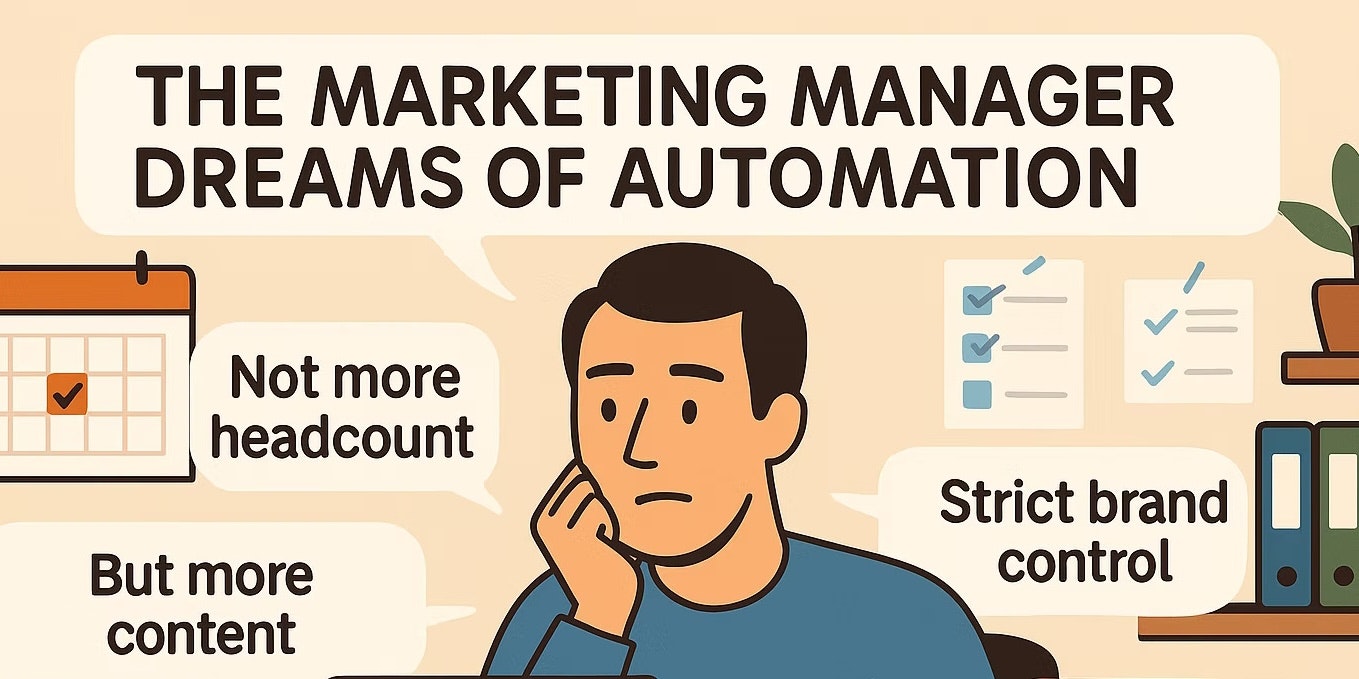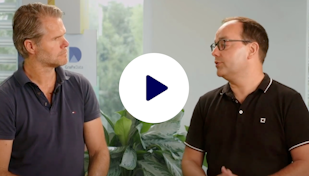The Marketing Manager’s Revenge: Turning Brand Chaos into Order

Monday morning. 8:47 AM. The campaign launch meeting was supposed to start ten minutes ago, but the Zoom link is broken, half the team is still in another time zone, and someone in Legal just “had a small question” about the fine print that’s actually a complete rewrite.
Slack is already on fire — 72 unread messages since last night.
Three new AI tools were added to the stack over the weekend (“This one will really save us time”).
And a designer just wrote:
"The product photo looks a bit off. It’s 2px misaligned in the EU version.”
Welcome to modern marketing management.
No one warned you that running brand campaigns would one day feel like air-traffic control for 40 markets at once.
Ten years ago, a marketing manager created briefs and approved storyboards.
Now they’re balancing fifteen platforms, four agencies, and three types of AI tools that all claim to “simplify” things.
The truth is, marketing management didn’t just evolve — it exploded.
And it’s not slowing down.
The job that changed overnight
If you talk to any marketing manager today, they’ll tell you the same thing: their job description didn’t keep up with reality.
In 2015, success meant launching a good campaign.
In 2025, it means launching hundreds of assets, across markets, formats, and channels — in real time, at half the budget, and preferably before lunch.
The old rhythm — a few major campaigns a year — is dead.
Now, marketing runs 24/7, like a streaming service.
One global retailer told me their marketing team produced 32,000 content variations in 2024 — banners, emails, product images, POS materials, videos — all generated for different audiences, languages, and devices.
In 2018, that number was 4,000.
That’s not a “bigger workload.” That’s a different universe.
The modern marketing manager is caught in the middle of this acceleration.
They’re expected to be both creative and operational, both strategic and tactical, both brand guardian and speed junkie.
They need to speak data and design fluently — while also explaining to finance why TikTok spends are “different.”
Their days are no longer structured around campaign launches but around managing a content machine that never sleeps.
The RFP tsunami
The flood of RFPs we’re seeing right now is not random.
It’s a collective cry for sanity.
Five years ago, “automation” was a footnote in marketing RFPs — something buried under “optional efficiency improvements.”
Now, it’s the headline:
“Marketing Production Transformation.”
“Smart Content at Scale.”
“AI-Powered Brand Management.”
Every global brand seems to be asking the same question in different words:
“How can we make more content, faster, without losing control?”
Agencies confirm it too — nearly every brief from major clients now includes a request to “create content smarter.”
The pattern is obvious: marketers are desperate for relief from the operational madness of content creation.
They’re not looking for inspiration; they’re looking for architecture.
Something that lets creativity flow without drowning in it.
The new RFP — the manifesto for control
If you’ve been reading RFPs lately, you’ve probably noticed: they sound less like “requests for proposals” and more like manifestos for control.
They used to ask: “Can you automate a few things?”
Now they ask:
“Can you give us one system to handle every channel — print, digital, social, in-store — while keeping full brand governance, connecting to our DAM, and pushing content directly to Sprinklr, Salesforce, and our printers?”
Not a simple question anymore.
These new RFPs tell a story. A very human one.
Brands aren’t just chasing efficiency — they’re chasing sanity.
Here’s what we’re seeing again and again:
One system for multiple channels.
The walls between print and digital are gone. A single source of truth must power every banner, every in-store poster, every social tile. One system. One logic. One visual language.
Absolute brand control.
No more “close enough” adaptations. If a campaign runs in 50 markets, every pixel, logo, color, and legal line must behave predictably. Fonts, rules, disclaimers — all hard-coded, not hoped-for.
Deep integration with DAMs.
Assets live everywhere — in cloud folders, creative servers, or someone’s laptop. Brands now want direct connections between creative systems and their DAM, so content can flow automatically instead of being uploaded, renamed, and relinked 15 times.
Connected delivery systems.
Content can’t stop at design. It must be ready for delivery — whether to printers, CDPs, or social schedulers like Sprinklr. The brief is clear: “Don’t just create it — publish it, deliver it, track it.”
Testing built-in.
Modern RFPs include detailed testing scenarios:
“Show us how the system handles 5,000 language variations, how it scales layouts dynamically, how approval flows work under deadline.”
It’s no longer about pretty slides. It’s about proof of performance under stress.
Aggressive timelines.
What used to be 12-month implementations are now expected in 12 weeks. The new marketing cycle doesn’t wait — and brands won’t either.
Beyond technology — full ownership.
The real request in all these RFPs? Not a tool. A system.
One that delivers measurable ROI.
Not “we’ll save time.” But “we’ll produce more, faster, cheaper, and with better brand consistency — at scale.”
The modern marketing manager didn’t write those RFPs.
They lived them.
They’re the ones who felt the chaos, lost nights to PowerPoint decks, and saw first-hand how disconnected tools waste creativity.
These RFPs are their revenge.
They’re finally asking for the infrastructure they should’ve had all along.
The day-to-day reality no one talks about
Every modern marketer has war stories.
Like the time a global promo went live with the wrong currency symbol in 17 markets because the template didn’t localize properly.
Or when the brand font broke halfway through a campaign in Arabic.
Or when an AI tool confidently generated product copy — but forgot the product actually existed in three different pack sizes.
This isn’t incompetence. It’s complexity.
Marketing has become a global operation with thousands of moving parts, and yet most companies still manage it with spreadsheets, scattered assets, and three people who “know how it works.”
The irony? The modern marketing manager has less control than ever.
More tech. More data. More dashboards.
But fewer systems that actually connect it all.
From campaign managers to systems builders
Something fascinating is happening behind the scenes.
The smartest marketing managers are no longer acting like campaign producers — they’re thinking like system architects.
They’re building what looks more like a content supply chain than a campaign plan:
inputs (creative, copy, data), processing (AI, automation, review workflows), outputs (thousands of brand-consistent assets).
They’re learning that creativity at scale is not about more hands — it’s about better systems.
In 2019, the job was: “Make a great ad.”
In 2025, it’s: “Make sure 500 ads stay on-brand, localized, compliant, and ready before next Tuesday.”
That’s a different muscle.
The modern marketing manager’s true superpower isn’t creativity — it’s orchestration.
They don’t paint; they conduct.
They’re the bridge between humans and automation, making sure the brand still feels alive, even when 90% of the content was generated or adapted by software.
A small revolution on our side
Let me share a real example from our own marketing team.
For years, updating our “What’s New” page and sending the monthly newsletter was a full-blown mini-project.
It required three people — content, design, and ops — to coordinate across tools, layouts, and approvals.
Three people, three days, every month.
You can imagine how much everyone loved that process.
Fast-forward to today.
The team automated it. Completely.
Now, all new articles, product updates, and stories feed directly into a system that automatically generates newsletter content and updates the “What’s New” page.
Formatting, visuals, even language versions — handled.
The team reviews, tweaks a few details, and hits publish.
Total time: 10 minutes.
What used to take three profiles three days now takes less time than a coffee break.
And that’s the point.
Automation isn’t about removing creativity — it’s about removing friction.
So the humans can focus on the ideas, not the file formats.
(Also, kudos to our marketing team for thinking in systems before most people even realized that was the job.)
Why 2026 will be the breaking point
We’re heading into a pivotal year.
By 2026, the marketing world will split in two:
- those who build content systems, and
- those who still manage content chaos.
The difference will be night and day.
Brands that adopt automation and AI-driven production will cut costs and timelines in half.
The rest will still be buried in feedback loops and approval chains.
The RFP boom we see today is only the beginning — a prelude to a deeper operational shift.
Marketing production is no longer an execution problem.
It’s a business transformation problem.
Every brand is becoming a media company — creating daily, distributing everywhere, and adapting constantly.
You can’t run that on PowerPoint and PDFs.
The future marketing manager
So who is the marketing manager of 2026?
They’ll look less like “brief writers” and more like content engineers.
They’ll think in systems, templates, and guardrails.
They’ll design for speed and control — because they know you can’t have one without the other.
They’ll work with AI that enforces brand rules automatically:
- no wrong currencies,
- no fonts that don’t exist,
- no off-brand visuals in regulated markets.
They’ll use automation to remove 80% of the grunt work — resizing, reformatting, localizing — freeing time for strategy and storytelling.
They’ll lead teams that finally feel like they can breathe again.
From chaos to control
The modern marketing manager is in the middle of a massive transition — from chaos to control.
But it’s not about working harder.
It’s about designing smarter.
The winners won’t be the ones shouting the loudest about AI.
They’ll be the ones who build sustainable, scalable systems — where creativity thrives because the machine runs smoothly underneath.
The future belongs to the marketers who stop thinking in campaigns and start thinking in systems.
Because that’s how you build brands that don’t just survive the flood — they steer it.
CEO insights
Kevin Goeminne
Nov 3, 2025


